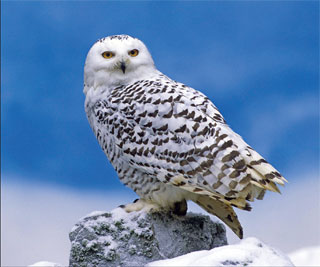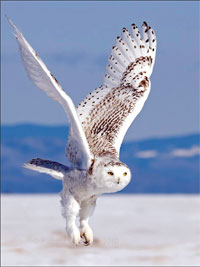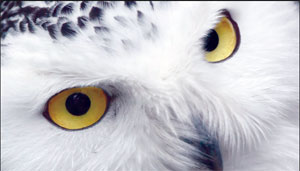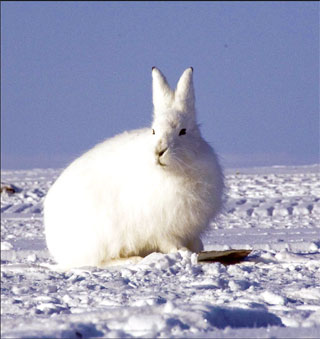|
Arctic animals:
Snowy owls and Arctic hares
There are many beautiful animals such as the Arctic fox, Arctic hare
and seals most of whom are snow- white in colour that live in the
coldest areas of the Earth. Today we feature two of these animals , the
Snowy owl and the Arctic hare .
 A
large owl with white feathers the Snowy owl (Bubo scandiacus) belongs to
the Strigidae family. A
large owl with white feathers the Snowy owl (Bubo scandiacus) belongs to
the Strigidae family.
The bird is also known in North America, as the Arctic owl, Great
White owl or Harfang.One of the largest species of owl in North America
the owl is about 52–71 centimetres (20–28 in) long and has a wingspan of
125–150 centimetres (49–59 in) . As Snowy owls are on average the
heaviest owl species. the owl can weigh anywhere from 1.6 to 3 kilograms
(3.5 to 6.6 lb).

The adult male is virtually pure white, but females and young birds
have some dark scalloping; the young are heavily barred, and dark
spotting may even predominate. Its thick plumage, heavily feathered
taloned feet, and coloration render the Snowy owl well-adapted for life
north of the Arctic Circle. Its eyes are yellow and beak is black. The
Snowy owl’s ear-tufts are small and usually tucked away.
The bird is found typically in the northern circumpolar region, where
it makes its summer home north of latitude 60 degrees north. However, it
is a particularly nomadic bird, and because population fluctuations in
its prey species can force it to relocate, it has been known to breed at
more southerly latitudes. Snowy Owls nest in the Arctic tundra of the
northernmost stretches of Alaska, Canada and Eurasia. They winter south
through Canada and northern Eurasia. They are attracted to open areas
like coastal dunes and prairies that appear somewhat similar to tundra.
This species of owl nests on the ground, building a scrape on top of
a mound or boulder. A site with good visibility, ready access to hunting
areas, and a lack of snow is chosen. Gravel bars and abandoned eagle
nests may be used. Breeding occurs in May, and depending on the amount
of prey available, clutch sizes range from 5 to 14 eggs, which are laid
singly, approximately every other day over the course of several days.
Hatching takes place approximately five weeks after laying, and the pure
white young are cared for by both parents. Both the male and the female
defend the nest and their young from predators. Some individuals stay on
the breeding grounds while others migrate.
What do you think this powerful bird survives on ? Primarily on
lemmings and other small rodents. However, when there is a shortage of
food its diet may change. In fact, the Snowy owl is known to be an
opportunistic hunter. Its prey species may vary considerably, especially
in winter.
During such times it would feed on a wide variety of small mammals
such as meadow voles and deer mice, but it will also take advantage of
larger prey, especially mammal which includes hares, muskrats, marmots,
squirrels, rabbits, raccoons, prairie dogs, rats, moles, and entrapped
furbearers.
The snowy owl also preys upon the feathered kind and they include
ptarmigan, other grouse ducks, geese, shorebirds, pheasants, grouse,
coots, grebes, gulls, songbirds, and even raptors, including other owl
species. It is also known to eat fish and carrion.It sure has a wide
variety of food to choose from.
 Like
all other owls the Snowy owl too hunts in the night. Most of the owls’
hunting is done in the “sit and wait” style; prey may be captured on the
ground, in the air or fish may be snatched off the surface of bodies of
water using their sharp talons. With a huge capacity to tuck in food,
each bird must capture roughly 7 to 12 mice per day to meet its food
requirement .Would you believe that it and can eat more than 1,600
lemmings per year? Like
all other owls the Snowy owl too hunts in the night. Most of the owls’
hunting is done in the “sit and wait” style; prey may be captured on the
ground, in the air or fish may be snatched off the surface of bodies of
water using their sharp talons. With a huge capacity to tuck in food,
each bird must capture roughly 7 to 12 mice per day to meet its food
requirement .Would you believe that it and can eat more than 1,600
lemmings per year?
You may be aware that most birds eat their food whole skin,fur,
feathers and all and later throw out what cannot be digested. Well, the
Snowy owl too swallows the small prey it catches whole. Strong stomach
juices help digest the flesh, while the indigestible bones, teeth, fur,
and feathers are compacted into oval pellets that the bird regurgitates
18 to 24 hours after feeding.
When large prey are eaten in small pieces, pellets will not be
produced.
Snowy owls have few predators but still the adult birds are very
watchful and are equipped to defend against any kind of threat towards
them or their offspring. During the nesting season, the owls regularly
defend their nests against arctic foxes, corvids and swift-flying
jaegers; as well as dogs, gray wolves and avian predators.
The male birds too play a major role when it comes to defending the
nest. They generally stand guard nearby while the female incubates the
eggs and broods the young. Both parents attack approaching predators,
dive-bombing them and engaging in distraction displays to draw the
predator away from a nest. Some species nesting near snowy owl nests,
such as the snow goose, seem to benefit from the protection of Snowy
owls that drive competing predators out of the area.
Snowy owls have incredible vision. They can see from high up in the
sky and swoop down silently to capture their prey. Like all owls they
have good night vision.
The mother stays on the nest and the father brings her food and
protects her. After the owlets are born both parents work to feed the
owlets. In eight weeks the owlets are ready to leave the nest.. This is
important because the summers are so short in Arctic regions. If the
owlets weren’t ready to take care of themselves they would not survive
the cold winter.

Arctic hares
Arctic hares are some of the most amazing animals living on our
planet. Arctic hares as well as all other hares are related to rabbits.
The arctic hares are very similar to mountain hares and snow shoe
hares.Like their name says, Arctic hares live north of the treeline..
Arctic hares live in Newfoundland and Labrador, Ellsemere Island and
Northwest Territories – all locations in the tundra ecozone.
They prefer dry areas in the tundra and avoid marshes.The hares can
endure the harsh winters that come with living there. In winter there is
little sunlight and temperatures can go down to -40 degrees Celsius.
However, in the winter their coat keeps them warm and makes them less
vulnerable to predators, as it acts like camouflage in the snow.Unlike
other mammals, hares do not hibernate throughout the winter.
They stay in herds and keep close, but they do not huddle together –
they like their personal space. Hares spread out to breed, each couple
preferring their own spot. Babies are born in the spring and reach
maturity in six months, ready to breed in one year. An Arctic hare has a
a great sense of smell that helps it find food buried under the ice and
snow. It can smell willows under the snow. Whenever it smells the willow
it starts to dig. If the snow is too deep the hare first thumps on it
with its powerful feet. It then gnaws ( chews ) at the icy crust with
its sharp teeth.Arctic hares are also reported to eat mosses, lichens,
buds, berries, blooms, leaves, sedges, seaweed, bark, willow twigs and
roots .
 While
being vegetarians, these hares are known to occasionally eat meat
especially d the meat from the traps of hunters. Arctic hares in the
winter usually feed in areas where snow is shallow or plants are exposed
by wind. When their food is buried under snow, Arctic hares rely on
their sense of smell to locate it.The females give birth to young from
late May to July. They are usually born grey-brown in colour. While
being vegetarians, these hares are known to occasionally eat meat
especially d the meat from the traps of hunters. Arctic hares in the
winter usually feed in areas where snow is shallow or plants are exposed
by wind. When their food is buried under snow, Arctic hares rely on
their sense of smell to locate it.The females give birth to young from
late May to July. They are usually born grey-brown in colour.
The farther north they are, the later the babies are born. Litter
size is from four to eight babies. Female arctic hares may produce a
second litter in one season.The mother doesn’t leave her babies for the
first few days.
By the third day the babies learn to stay still, so they look like
the rocks and grass around them. The young arctic hares gain 45 to 50
grams (0.1 - 0.11 lb) per day in their first month and no longer need
mother’s milk by the time they are 1 month old. By around September they
reach the size of their parents. The young arctic hares are weaned
abruptly in late August, but they continue to feed and rest together at
least into September. In areas with large populations, the young from
different litters sometimes gather into larger groups. They grow rapidly
and by late autumn are almost indistinguishable from the adults.
We do not know if the young arctic hares take part in the spring
breeding in their first year, or if they are ready to mate only in time
for their second spring. Arctic hares live for about 4-6 years.
Arctic hares are food for snowy owls, other birds of prey, wolves,
foxes, weasels, and polar bears. So it must always be alert and ready to
hop away if it senses an enemy. People also hunt Arctic hares for food
and other reasons.
[Fast facts]
* Arctic hares have black eyelashes that protect their eyes from the
sun’s glare, just like sunglasses.
* The hares’ coats change colours slightly from season to season. In
winter the coat is bright white and in summer white with an ashen tinge.
Despite seasonal changes, their tail is always white.
* Their eyes are placed on each side of their head giving them a view
of 360 degrees without turning their head.
* Normally they move with the front legs taking the first steps
separately, followed by the hind legs stepping together. When they sense
danger hares first stand up on their hind legs to assess the area, then
bolt. They can jump as far as 2.1 metres in a single bound and can move
approximately 60 kilometres an hour.
* The Arctic hare’s large back feet act like snowshoes that help to
keep them from sinking in the snow. Their front feet have long, strong
claws that help them dig beneath snow to find food.
* They eat woody plants, such as willow twigs , roots and mosses .
* Arctic hares can also be referred to by the names Arctic rabbit,
artic hare (misspelled), polar hares, mountain hares, Lepus arcticus,
Alaskan hares or white hares.
* The Snowy Owl was first classified in 1758 by Carolus Linnaeus, the
Swedish naturalist who developed binomial nomenclature to classify and
organise plants and animals.
* The Snowy Owl is the official bird of Quebec.
* They are nocturnal and diurnal hunt at night but in the Arctic it
doesn’t get dark in the summer so the owls hunt in the daylight too.
* When the owl gets food it swallows it whole or tears it into large
pieces to swallow.
Courtesy: Internet |

